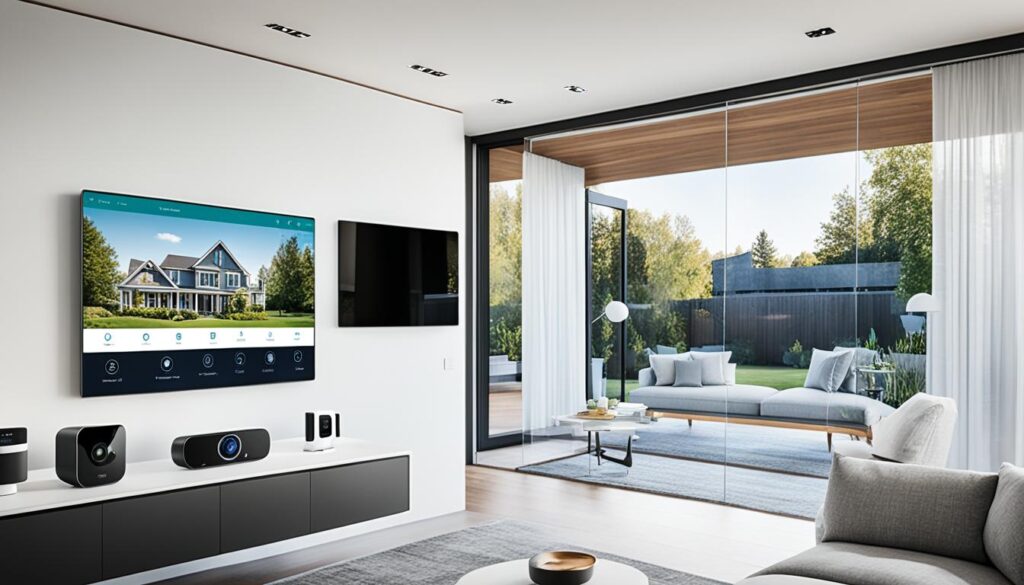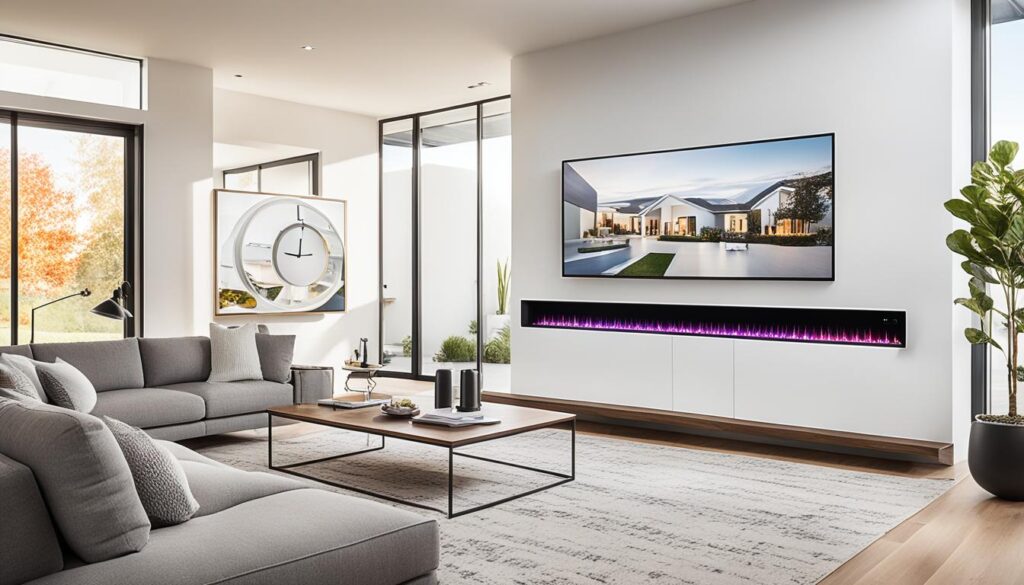Smart home technology has changed how we keep our homes safe. It offers features for better security, monitoring, and tailored safety plans.1 These systems use connectivity and smart features to alert us in real-time, detect falls, manage medicine, and control access better. Together, they make our homes safer.2 This guide will look at how smart home tech benefits us, how to add various devices, and tips to make our smart homes safe.
– Smart homes have many safety features like watching from afar, seeing if someone falls, and helping with medicine.
– Adding smart devices can boost security with things like smart locks and cameras.
– It’s important to protect the smart system from online threats.
– Insurance experts are big on smart home tech, teaching clients why it’s good.
– We need to get past concerns about cost and not knowing enough to make smart homes common.
The Rise of Smart Home Technology
A recent survey in the United States shows more people are choosing smart home technology. 34% own smart video doorbells, and 32% use smart security cameras. These numbers highlight a strong desire for better security and ease in homes.3
Increased Adoption of Smart Home Devices
Survey results point out why homeowners are turning to smart devices. For 44%, it’s about reducing worries and feeling safe.4 Also, 34% focus on how smart devices save energy, and 35% see their overall value.4 This shows a rising appreciation for the real benefits of smart technology in making home life better and safer.
Homeowners’ Motivations for Embracing Smart Home Tech
While no single smart device is in over 30% of homes, 77% believe smart tech lifts their life’s quality.5 Moreover, 85% say their choices are based on what they need and like, rather than going for a full suite of gadgets.5 Homeowners are picking smart solutions that meet their specific needs and wants.
| Key Smart Home Adoption Insights | Percentage |
|---|---|
| Consumers who believe smart home devices improve quality of life | 77%5 |
| Consumers who prioritize specific functions over an ideal smart home | 85%5 |
| Consumers who will buy and install one or two smart home devices | 45%5 |
| Users who think interoperability is important in smart home devices | 79%5 |
| Users who control smart devices primarily through smartphone apps | 45%5 |
| Users who have landed on a specific smart home system | 31%5 |
This survey offers deep insights on the rise of smart homes and the motivations behind it. With clear benefits like better security and saving energy, the trend to adopt smart technology is on the rise.
Smart Home Safety: A Comprehensive Guide
This guide will dive into smart home safety. It will help homeowners use smart home technology to boost security and well-being.6 It discusses the benefits of smart devices, how to combine different systems, and securing your home network. The aim is to make homes safer and more connected.
The smart home safety guide looks at smart devices. It offers solutions that meet your needs. The guide ensures your smart home is secure. It also highlights remote monitoring, fall detection, and managing medication. This gives a full view on home safety with smart devices.
It explores the newest in smart home tech. It talks about how it might affect insurance costs. This guide shows the future of smart home safety. It looks at the changing world of home security and automation.
Whether you love tech or you’re new to smart home security features, this guide is for you. It gives tips and steps to make your living space safer for everyone.
Key Benefits of Smart Home Devices for Safety
Smart home technology makes homes safer by using smart features. A big advantage is that you can check on your home and get alerts from anywhere. With sensors and cameras, your home can watch for odd activities or emergencies. This lets you or your loved ones know right away. Then, quick actions might prevent a problem, keeping everyone safe.7
Enhanced Security with Smart Locks and Cameras
Smart locks and cameras boost home security significantly. Smart locks allow keyless entry, so you can manage who gets in when you’re not there. You can even give guest codes. The cameras then back this up by showing who’s trying to enter. This duo makes your home much safer.8
Fall Detection and Prevention
Smart devices also help with fall detection and making sure they happen less often. Placed around the house, sensors can spot if someone falls or their regular movements change a lot. This then alerts caregivers or the right authorities. It’s great for seniors or anyone who might be at risk, offering an extra safety layer.7

Integrating Smart Home Devices for Optimal Safety
Creating a full smart home safety system by joining different tech devices is key. When the technology fits personal needs and choices, it makes living areas safer.9
Tailoring Solutions to Individual Needs
It’s crucial to know what each home needs for smart tech to work well. For some, preventing falls is a priority, for others, it’s about better security or managing medicine. Experts in smart tech and senior care can suggest the right devices and settings for these needs.9
Connecting Various Smart Home Devices
Linking devices like motion sensors, cameras, locks, and medicine systems makes a smart home work together. This setup makes sure all systems talk to each other. So, when there’s a safety problem, the right alerts and help come quickly.9
Personalized Care Interventions
Smart tech also brings personal care solutions. For instance, wearables can watch health signs and warn about falls. Robots or virtual helpers can keep people company and sharp. Mixing these tools makes homeowners safer, more independent, and happier.9
Smart Home Safety
Smart home tech is a powerhouse in making our homes safer.10 It’s great at not just detecting but haulting falls. Sensors can watch how we move and spot sudden changes. If a fall is picked up, it alerts people who can help right away.10 This is a big plus for the elderly or those with trouble moving.
Keeping an eye on things from afar is also key for safety.10 With smart cameras and sensors, you can check on your house anytime. You get alerts on your phone if anything strange happens. This lets you act fast to keep your home safe.
Medication Management and Reminders
Staying on top of medications is a breeze with smart tech. Set up a smart pill dispenser to give out medicine when it’s time. This helps avoid missing doses.10 It can also ping you or a caregiver to make sure meds are taken on time.
Smart Locks for Enhanced Security
Smart tech plays a big part in boosting home security, too.10 Smart locks ditch the need for keys and let you manage who gets in from far away. You can set up codes for visitors. Plus, they work hand in hand with other security gadgets. This all adds up to a safer home.

Securing Your Smart Home Network
Smart home tech makes our lives easier but also puts us at risk.11 First, make your Wi-Fi network safe. Use a strong password and change the network name to something not easy to guess. Always pick the best security option, like WPA2 or WPA3.
Securing Your Wi-Fi Network
Make sure your gadgets are always updated. Check for updates often and get them as soon as they’re available. This keeps your gear safe. Also, upgrading to new routers with the latest tech helps a lot.
Updating Firmware and Replacing Outdated Routers
Keep your passwords strong and use different ones for each device. Make use of tools that can remember everything for you. Adding an extra security check with MFA is smart. It stops bad guys even if they guess your password.
Managing Account Passwords and Enabling Multi-Factor Authentication
Create a special network just for your smart home stuff. This can stop problems from spreading to your main network. It protects your important stuff.
Separating Networks for Smart Home Devices
Always watch for anything unusual happening on your network. Use special tools to help keep track. This way, you can catch and fix any problems fast.
Monitoring Your Network for Vulnerabilities
The Role of Insurance Agents and Carriers
Insurance agents and carriers are key in getting homeowners to use smart home tech. This is seen as a way to prevent different dangers. The Nationwide Homeowners Survey showed that 78% of agents tell their clients to get these products.12
Recommending Smart Home Products for Risk Mitigation
They often point out certain smart devices that tackle common risks. The survey mentioned that smoke or carbon monoxide sensors are top picks (56%), along with smart locks and water sensors (54% each).12 By focusing on these, agents guide homeowners to set up better protection. This helps lower the chance of claims and makes homes safer overall.
Educating Homeowners on Smart Home Technology Benefits
Insurance pros also teach the pluses of these techs to homeowners. They talk about how smart devices can bring peace, save energy, and cut costs. This info aims to knock down reasons people might not want these techs, like not seeing them as a must or not getting them.12 By doing this, they push homeowners to welcome these advancements. They show how it can make their homes safer and more secure.
Overcoming Barriers to Smart Home Adoption
Many homeowners know the benefits of smart home tech but hold back. They see barriers to using these new ideas. A survey by Nationwide found key obstacles to the adoption of smart home tech.
Addressing Cost Concerns
The high cost of smart home gadgets or services is a major issue. 45% of homeowners see the price as too high, stopping them from getting on board.13 Dealing with this issue means showing homeowners the growing number of affordable options. It’s important to explain the long-term value and savings these devices offer.
Demonstrating the Necessity of Smart Home Devices
Many think smart gadgets aren’t needed for their lifestyle. In the survey, 44% said they don’t need these products.13 To change their minds, people need to understand how these devices can make their lives safer, more convenient, and better in all ways.
Bridging the Knowledge Gap
Lack of knowledge is also a hurdle, found among 34% of homeowners.13 Educating them on what smart home tech can do is key. Hands-on demonstrations and clear information about how these devices work is vital. Showing that they are easy to use and can be customized helps too.
To make smart homes more common, focus on costs, show the need for these devices, and teach people about smart tech. Insurance professionals, tech companies, and others have a big role to play in this. Giving homeowners the right info and tools is essential for the future of smart home safety.
Future of Smart Home Safety
Smart home technology is getting better every day. Soon, our homes will be safer because of it. New sensors, artificial intelligence, and ways to study data are coming. They will make our smart devices smarter.14
Advancements in Smart Home Technology
In the future, smart home systems will work better with other devices. They will connect things like lights, heat, and security. This will make homes smarter and safer.14
This will help make running our homes easier. It will also make safety features in our homes better and more personalized. So, our homes will take better care of us.14
Integration with Home Automation Systems
Smart homes might change how we pay for insurance, too. If insurance companies see how these devices lower risks, they might give savings to smart homes’ owners. This way, smart homes can help make insurance cheaper. And insurance companies might not have to pay as much for claims.14
The Potential Impact on Insurance Premiums
What’s next? Our smart homes will get even safer. They will offer us more security and better connections to our lives. So, the future of smart home safety brings more peace, more protection, and a better life for all.14

Conclusion
Smart home technology is changing how we keep our homes safe. It uses connected devices to give us better protection, convenience, and peace of mind. These devices have new features that make homes safer.15
This tech allows for things like remote checks and quick alerts. It also brings advanced security and personal care tools.15 As these innovations grow, smart home safety will get even better. It will link with more home systems, and it might even lower your insurance costs.
Many people worry about the cost and learning curve of smart home tech. But, with help from insurance companies and tech experts, we can use these tools well.15 They help us to secure our homes better. This support is key for more people to enjoy safer and smarter living spaces.
FAQ
What are the key benefits of smart home devices for home safety?
Smart home devices bring remote monitoring and real-time alerts for improved safety. They also offer smart locks and cameras. Plus, there’s fall detection and prevention. All these together can make a big difference in how safe a home feels.
How can I integrate various smart home devices to create a comprehensive safety system?
To boost safety, personalize your smart home setup. Link devices such as motion sensors, security cameras, and smart locks. This makes your home smart, alert, and protective.
What are the important steps to secure my smart home network?
Make your smart home network safe by following a few steps. First, secure your Wi-Fi. Always update your devices. Use strong, different passwords for each. Turn on multi-factor authentication for extra security.
Also, set up a network just for your smart home gadgets. Regularly check for network weaknesses. This keeps your smart home safer.
How do insurance agents and carriers encourage the adoption of smart home technology?
Insurance pros suggest smart devices that protect homes better. Devices like smoke alarms, smart locks, and water leak sensors top their list. They point out how smart tech boosts energy efficiency and saves money, and its benefit is in peace of mind.
What are some of the barriers to widespread adoption of smart home technology?
High smart home product costs, seeing them as non-essential, and not understanding them are hurdles. To overcome, focus on educating people. Show smart tech makes life safer and more convenient. Demonstrate how it can be affordable over time.
What does the future hold for smart home safety?
The future of smart safety is bright. We will see better sensors, AI, and data analysis. This means homes will be smarter at spotting and reacting to dangers. Tied with home automation, security and comfort will leap. This could also affect insurance costs.
Source Links
- https://agetechcollaborative.org/custom_resource/smart-home-tech-for-older-adults/
- https://www.nautilusshc.com/blog/technology-for-senior-safety-at-home
- https://insightss.co/blogs/the-rise-of-the-smart-home-how-technology-is-changing-the-way-we-live/
- https://www.nahb.org/advocacy/legal-issues/smart-home-technology
- https://www2.deloitte.com/us/en/insights/industry/telecommunications/connectivity-mobile-trends-survey/2023/smart-home-industry-adoption-trend.html
- https://www.security.org/smart-home/
- https://www.gensecurity.com/blog/benefits-of-smart-home-technology
- https://avisiouk.com/blog/benefits-of-smart-home-security
- https://www.americanalarm.com/blog/making-your-home-smarter-the-power-of-smart-home-security-system-integration-024251
- https://www.kaspersky.com/resource-center/threats/how-safe-is-your-smart-home
- https://www.mcafee.com/learn/how-to-secure-your-smart-home-a-step-by-step-guide/
- https://agentblog.nationwide.com/personal-lines-insights/risk-prevention/survey-reveals-homeowners-trends-in-embracing-smart-home-technology/
- https://www.linkedin.com/pulse/smart-home-insights-unlocking-potential-locks-overcoming
- https://www.adtsecurity.com.au/blog/interactive-security/future-home-security-smart-security/
- https://www.ftc.gov/system/files/ftc_gov/pdf/PrivacyCon-2022-Sun-Child-Safety-in-the-Smart-Home.pdf
